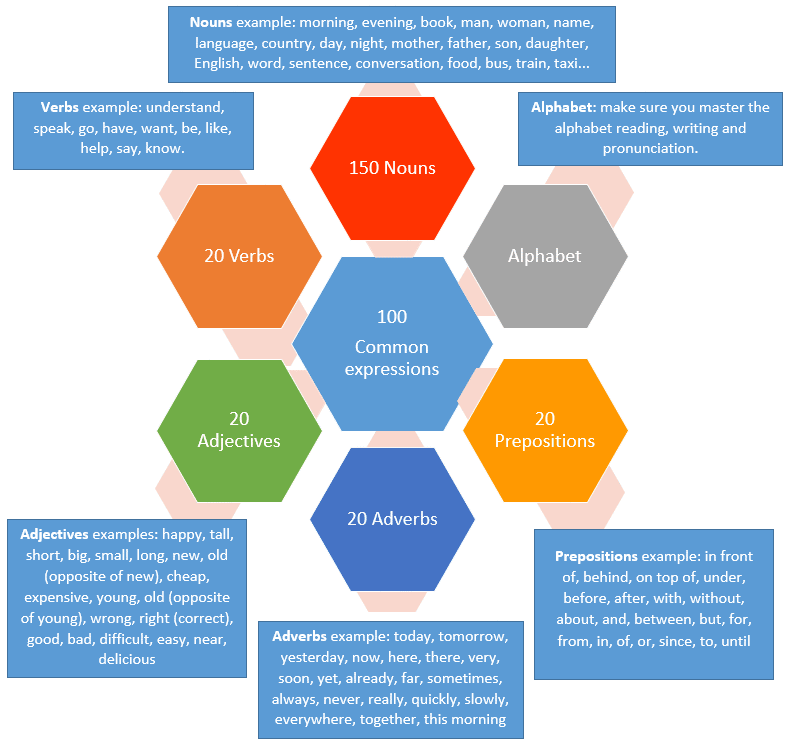Tips learning a new language
To learn a new language, you will need to have a road map to follow, because without a plan, you may not make sustained progress. This is our suggested learning map which could help you learn faster, since the map focuses mainly on the most important components of the language.
Most daily expressions contain the following building blocks: nouns, verbs, prepositions, adjectives and adverbs. To be able to complete level 1 of learning a language you need to memorize and know how to use about 330 words. The end result will be, the ability to create more than 10000 useful and popular sentences by using different combinations of those 330 words

10 Steps to achieving level 1
Step 1 learn the alphabet: Start with the alphabet (pronunciation). Learning the alphabet is a good start to deciphering the written characters of a given language. Try to learn how to read, write and pronounce each letter.
Step 2 master the phrases: Memorize 100 most commonly used expressions. This consists of complete sentences (i.e. Good morning! I don’t understand! How do you say this word in ...? Can you repeat please? ...). The list of expressions should include what you think you will need on a daily basis. Memorize the expressions by heart!
Step 3 know your nouns: Memorize 150 common nouns because most sentences contain nouns. For example: morning, evening, book, man, woman, name, language, country, day, night, mother, father, son, daughter, English, word, sentence, conversation, food, bus, train, taxi...
Step 4 common verbs: Memorize 20 common verbs (i.e. understand, speak, go, have, want, be, like, help, say, know, etc.). Verbs are important because they allow you to add an action, or state of being to your sentences. Make sure you also learn how to use the appropriate pronouns (I, you, she, we ...) and tense (past, present, future) with each verb (i.e. I speak, you speak, she went, give me ...).
Step 5 prepositions are important: Memorize 20 common prepositions because they convey the relation between one word and another (i.e. in front of, behind, on top of, under, before, after, with, without, about, and, between, but, for, from, in, of, or, since, to, until).
Step 6 popular adjectives: Memorize 20 common adjectives because you will need them very often. Examples are: happy, tall, short, big, small, long, new, old (opposite of new), cheap, expensive, young, old (opposite of young), wrong, right (correct), good, bad, difficult, easy, near, delicious.
Step 7 conquer your adverbs: Memorize 20 adverbs because that’s how you can express the manner, place, time, or degree of doing things (i.e. today, tomorrow, yesterday, now, here, there, very, soon, yet, already, far, sometimes, always, never, really, quickly, slowly, everywhere, together, this morning).
Step 8 practice your memorized words! Even though you memorized only 330 words, in reality, those words can help you create more than 10000 useful and popular sentences. So practice your newly acquired words by using different combinations. The best way to learn how to swim is to go and swim. It is also true to some degree when learning a new language. Get out there, talk to native speakers, neighbors, skype pals or by using one of the many apps available out there. It is very important to practice with a native because you’re offered the opportunity to learn the correct pronunciation, use of popular daily expressions, and receive immediate feedback.
Step 9 be persistent! Learning a language requires persistence. It is better to study consistently for 2 hours/day for 1 month, than to study 8 hours/day for the 1st week and then stop for 3 weeks. To make newly memorized words stick, you should use them in a sequence. For example, memorize them the 1st day, then test yourself on the 3rd day, 7th day, 2nd week and 4th week. The more you practice those words, the longer you will need to refresh your memory. One way of testing your memory is by writing, reading, using flashcards, quizzing yourself, chatting or simply talking to people.
Step 10 don’t be shy! Mistakes and awkward conversations are going to happen. Don’t be afraid of them and embrace them as part of the learning experience. Natives will appreciate your effort to learn their language and will help you along the way. Making mistakes is part of the learning experience and it is better to make a mistake when saying something than to not be able to say it at all.
This road map can be achieved in as little as 1 month. There are factors which could make it take longer to complete such as: how many hours you dedicate per day to learning, how different the language you’re trying to learn from your native language and what tools you are using to achieve your goal.
Whether you have plenty of time to dedicate to studying, or not, try to make it a pleasant and fun experience. Good luck!
If you have any question about the lessons or the website, please contact me homepage.